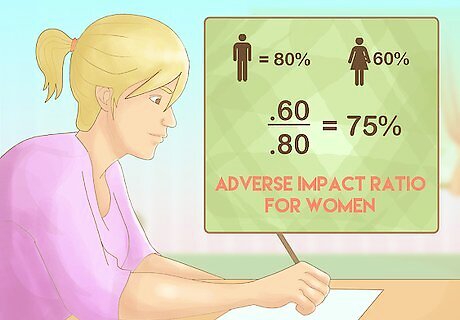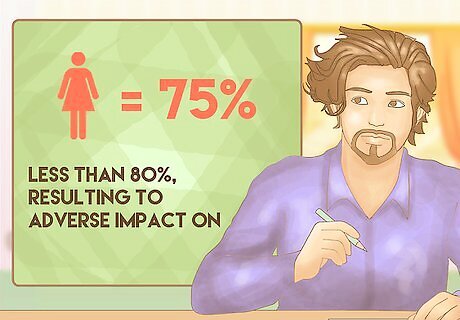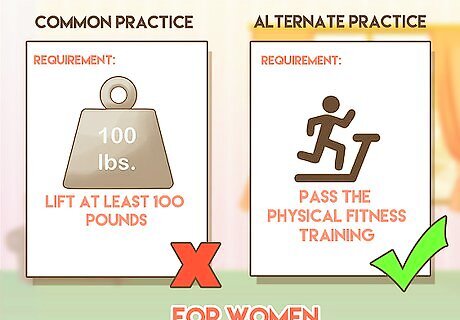
views
X
Research source
[2]
X
Trustworthy Source
US Equal Employment Opportunity Commission
U.S. government agency that enforces civil rights in the workplace
Go to source
Because of this, legal action can be brought against an employer if its policies or selection practices have discriminatory effects unless the employer can show that it adopted the policy or practice in question to serve a legitimate business purpose.[3]
X
Research source
To establish that an employer has violated Title VII—and prove a disparate-impact employment discrimination case—a plaintiff must demonstrate that a specific employment policy or practice caused an adverse impact on a protected class of individuals.
Calculating Adverse Impact

Understand the test. The Equal Employment Opportunity Commission, the Department of Labor, the Department of Justice, and the Office of Personnel Management have all adopted a test known as the "four-fifths rule" to calculate adverse impact. This test compares the rates of selection for lesser-represented classes of individuals against the rate at which the most-represented group is selected. If any lesser-represented group has a selection rate that is less than four-fifths (or 80%) of the selection rate for the most-represented group, this can be used as evidence that discrimination—or adverse impact—is present. So, if 90% of men who apply for a particular position are selected, and women are selected for the same position at a rate lower than 72% (80% of the highest selection rate, 90%), this would be evidence of adverse impact.

Identify the policy or practice at issue. To demonstrate adverse impact, a plaintiff must show that a particular policy or practice on the part of an employer results in a certain amount of discrimination towards a protected group. Therefore, your first step should be to identify the selection requirement that is responsible for the differing rates of selection. By way of example, let's use a requirement that, to be a police officer in a particular city, an applicant must be able to lift at least 100 pounds.

Calculate the rate of selection for each group. The next step in calculating adverse impact is to establish the selection rates for each group of individuals. This is done, for each group, by dividing the number of applicants selected for employment by the total number of applicants. These selection rates will then be compared in a later step. Returning to our example, let's say 100 men and 100 women applied to be police officers in our hypothetical city. 80 men and 60 women were selected for the position. So, the selection rate for men would be 80% (80/100) and the selection rate for women would be 60% (60/100).

Note which group has the highest selection rate. The next step in this process is to determine which group has the highest selection rate. This rate will be used as the point of comparison on which a determination of adverse impact can be made. In our example, men have the highest selection rate for the police-office position, at 80%.

Calculate adverse impact ratios. Once you have calculated the selection rates and determined the group with the highest rate, the next step is to determine the "adverse impact ratio" for each other group, which represents how each group's selection rate compares with the most-represented group's rate of selection. This is done by comparing the selection rate for each group against that of the most-represented group, in which you are basically comparing the rate for the adverse group with the rate for the favored group by dividing the former by the latter. In our example, we would divide the selection rate for women by the selection rate for men (.60/.80) and arrive at an adverse impact ratio for female applicants of 75%.

Determine if adverse impact exists. Once you have calculated the adverse impact ratios for each group, evaluate each adverse impact ratio using the four-fifths rule. This is the simple part. If the adverse impact ratio for a particular group is less than 80%, according to the four-fifths rule this can be used as evidence that the employment policy, practice, or procedure is discriminatory in some way towards that group. Basically, this means that a member of the less-represented group is selected for a position less than 80% of the time a member of the most-represented group is selected for the same position, which many federal agencies consider evidence that discrimination is taking place. Returning to our example, the impact ratio for female applicants is 75%, which is less than 80%, meaning that the policy of requiring police officers to be able to lift at least 100 pounds seems to have an adverse impact on female applicants. While the four-fifths rule is not controlling in court, it is consistently recognized by courts as a proper factor for courts to consider when determining if adverse impact is present in an employment-discrimination case.
Proving Disparate Impact

Demonstrate adverse impact. The first step in proving a case of disparate-impact employment discrimination—where a plaintiff argues that an employer's practice or policy results in discrimination against a protected group—is to establish causation. That is, that the policy caused discrimination on the basis of a protected status (e.g., race, religion, or sex). There is no constant standard courts use to satisfy this causation requirement. While many federal agencies have explicitly endorsed the four-fifths rule detailed above, other courts have rejected it. The only guidance given by the Supreme Court on this issue is that statistical disparities must be "sufficiently substantial" to the point that they suggest causation between the disputed employment practice and a lower selection rate for a protected group of individuals. So, if we continue with our above example, the selection criteria of requiring police officers to be able to lift at least 100 pounds would seem to have an adverse impact on female applicants according to the four-fifths rule.

Take note of the employer's justification. After the plaintiff has demonstrated the existence of adverse impact (e.g., by using the four-fifths rule), the employer is given the opportunity to show that the disputed policy or practice is job-related and serves some business necessity. For example, the police department might claim that, in its view, police officers should be able to lift a minimum amount of weight because this signifies a certain amount of physical fortitude and conditioning necessary to carry out the duties of a police officer. Therefore, the requirement that all police officers be able to lift at least 100 pounds is not meant to discriminate against women, but is instead meant to ensure an optimal level of physical fitness throughout the city's police force.

Show that an alternative practice is less discriminatory. If the employer is able to provide a justification for the disputed practice, a plaintiff can still win in a disparate-impact case if the plaintiff can point to a different practice the employer could have used instead (but didn't) that would have resulted in less discrimination. So, the police department in our example justified the 100-pound requirement by stating it wants its officers to maintain a certain level of physical fitness. A plaintiff could argue that, instead of using weightlifting ability as a measure of physical fitness, the department could have used a different, less-discriminatory measure, such as medical physical-fitness evaluation prior to beginning employment, or mandatory participation in physical-fitness training after accepting employment as a police officer.




















Comments
0 comment